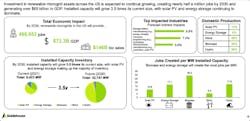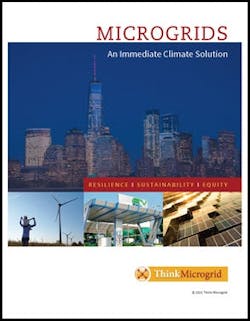New Studies Point to Microgrids as ‘Once in a Generation Solution’
More microgrids mean more jobs. Americans across the political divide increasingly favor microgrids. And the technology opens a pathway for policymakers to implement an all-in-one climate solution.
Those are the messages from three reports released in unison today that together make a case for government action to support microgrids, according to the report sponsors.
“Together, these reports clearly demonstrate that microgrids that use renewable energy can be a powerful engine for change, not only for our environment and resiliency, but also for our economy. The public is ready, and support is growing,” said Pam Solo, president of the Civil Society Institute (CSI), a nonprofit, nonpartisan research and education organization focused on advancing civic engagement on issues that directly affect individuals and their communities.
Cameron Brooks, executive director of Think Microgrid, an advocacy group and affiliate of Microgrid Knowledge, described the findings as groundshifting.
“We depend on the grid, but we learn every day and with every storm how brittle it is. It doesn’t have to be and what these reports highlight is how making our grid more resilient will also boost the economy with new jobs and bring more security to the systems we depend on,” Brooks said. “The infrastructure bill signed into law this week dedicated billions of dollars to bring equitable resiliency to the grid, and these reports make it clear that this will create new jobs and is exactly what voters are asking for.”
- Microgrids: An Immediate Climate Solution by Think Microgrid (vision paper).
- The Renewable Energy Economic Benefits of Microgrids by CSI, RMI and the Millennial Action Project (jobs report).
- Microgrids 2021 (public opinion research) by Lake Research Partners, CSI and VJBreglio.
First microgrid jobs report
The economic report marks the first effort to quantify how microgrids translate into jobs.
Prepared by Guidehouse, the report finds that by 2030 renewable microgrids in the US will generate 500,000 new jobs, $72 billion in GDP growth and $146 billion in sales across the supply chain.
The study derived its figures by looking at the renewable energy, energy storage and microgrid controller components of microgrids, and it assumes 32 GW of microgrids will be installed by the end of the decade.
Peter Asmus, author of the economic study and research director at Guidehouse, noted that the research did not consider the impact of a microgrid tax credit included in the Build Back Better bill now before Congress.
“If that indeed does move forward, these benefits will all increase,” said Asmus, during a viewable panel discussion of the findings.
The economic study honed in on California and Puerto Rico, two areas hastening microgrid development to deal with climate disasters.
In California, the microgrid market will grow to 14.5 times its current size, largely because of efforts to limit fossil fuels and build microgrids that feature carbon-free resources to aid the larger grid. Such growth would create 10,500 MW of microgrids in the state by 2030 that would lead to 166,600 jobs and a positive GDP contribution of $22.2 billion with $45.5 billion in business sales, according to the study.
Puerto Rico will add more than 9,000 jobs, generating over $1.2 billion in GDP and adding $2.59 billion in business sales with the addition of 738 MW by 2030, a tripling of current microgrid capacity, the study said.
The largest number of jobs across the two states, as well as the US, will be created by the energy storage equipment within microgrids followed by the solar equipment.
Roy Torbert, senior principal of RMI, which has been working on microgrids in Puerto Rico as both a climate change solution and a way to create more local control of energy, said that the report “gives further proof that solutions exist and are within our reach.”
“Microgrids will help increase the resiliency of the electric grid by helping communities become more prepared to prevent power outages due to extreme weather and other natural disasters and recover quicker. But as this report shows, enhancing our resiliency through microgrids will also boost our economy and add jobs,” Torbert said.
79% of Americans support microgrids
The second report, a public opinion survey, builds upon polling done last year that showed voters support microgrids when they understand what they are. That support increased in the new survey of 1,200 adults done last month.
Seventy nine percent of Americans now favor increasing use of microgrids in our electric grid, up from 67% in the 2020 survey.
The findings indicate “some real movement towards supporting this idea in light of some of the headlines in terms of grid outages in Texas and other extreme weather events that have impacted electricity distribution across the country, in Puerto Rico and elsewhere,” said Jonathan Voss, a partner at Lake Research Partners.
The support correlates with familiarity, he said. “The more likely you are aware of what microgrids are, the more likely you support increasing use of them in our electric grid.
Of the 26% of adults familiar with microgrids, 91% favor increasing use of microgrids, 64% strongly.
“These are very, very strong numbers. And this is across party lines,” Voss said. Of those favoring microgrids, 86% are Democrats, 75% Independents and 74% Republicans.
Especially interesting, Voss said, is the big jump in Republican support over the last year — a 24% rise.
Microgrids a “once in a generation solution”
Gen Z and millennials showed the strongest understanding of microgrids in the polling.
This fits with how Layla Zaidane, president and CEO of the Millennial Action Project, describes the concerns of younger generations. Her group activates young leaders to build relationships across the political spectrum.
“For young Americans, fewer issues are more pressing than addressing energy supply and resiliency for a more sustainable future. Our grandparents’ electric grid desperately needs modernization. Microgrids have emerged as a key intervention for forward-looking lawmakers to act on now,” said Zaidane.
“What I really hope walking away from this is that this moment can have a ripple effect across our broader society,” said Zaidane, who participated in the panel discussion. “We truly believe microgrids are a once in a generation solution.”
The role of government leaders
- Protect citizens and the economy from energy disruptions already upon us because of climate disasters.
- Redesign the electrical system with the future in mind, introducing cleaner energy technologies to counter even greater weather extremes in the decades to come.
- Make these changes in an equitable fashion, providing distributed clean energy — and the economic prosperity it can bring — to all communities.
“Technology catches up with — and often outpaces — policy, which means that policymakers today bear a great responsibility. They are charged with designing utility markets that are resilient, clean and equitable. This is a daunting task, but they do not have to act in isolation,” Brooks wrote in a preface to the vision paper. “Speaking with a unified voice, Think Microgrid provides political leaders with the resources they need to understand how microgrid technologies work, what role they can play in achieving policy goals and how regulatory reforms can proactively address barriers that exist today.”
During the panel discussion, Brooks cited a range of microgrid issues on the table for policymakers to consider, among them microgrid regulation, rate design, access to open markets and the locational value of energy and resiliency.
He added that the timing of the joint announcement is good because microgrid policy seems to be at an inflection point, with “great interest within the regulatory community.”
By way of example, he noted activities underway before the Department of Energy and other federal agencies, various states and the research community.
“More than anything else it is now into late night TV comedy. Jon Oliver actually spoke the word microgrid the other day in a long and very intelligent segment on planning. So I think our time is now,” Brooks said.
Interested in microgrids? Subscribe to the free Microgrid Knowledge Newsletter.
About the Author
Elisa Wood
Editor-in-Chief
Elisa Wood is the editor and founder of EnergyChangemakers.com. She is co-founder and former editor of Microgrid Knowledge.


